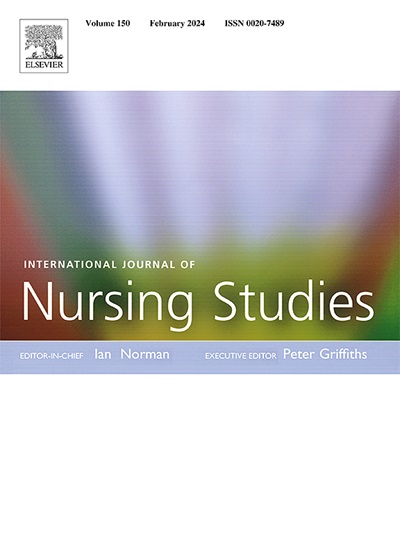The reality of neonatal nursing work in Kenya and implications for quality and safety: Direct observation of tasks and time utilisation
IF 7.1
1区 医学
Q1 NURSING
引用次数: 0
Abstract
Background
Little is known about how nurses working in care settings affected by remarkably high workloads and workforce constraints manage their work and time to deliver needed care.
Objective
This study aimed to characterise nursing workflows and examine time allocated to care in high mortality, intermediate care Kenyan neonatal units.
Design and methods
Using ‘shadowing’ as a time and motion technique, we directly observed 1–2 nurses per 12-hour shift in 8 Kenyan county hospitals. We used an Activity Log Sheet to document their activities during the shift and thematic content analysis of observation notes to classify and group tasks performed. In a second phase, we documented the time spent on specific critical tasks and instances of multi-tasking and care interruptions.
Results
We directly observed 499 person-hours over 36 day shifts and 15 night shifts. A typical day and night shift had a median of 38 (25–47) and 32 (18–44) babies respectively with a median nursing hours per-patient per-shift of 0.9 (0.5–1.2) hours. We recorded 1891 task episodes comprised of 36 different tasks that we grouped into eight workflow domains. Most tasks involved: direct patient care (37 %) or indirect patient care (23 %) with communications, documentation and reporting, staff or student supervision and mentorship, interruptions, personal breaks, and rest less frequently performed tasks. Nurses commonly devoted up to 20 minutes even to critical tasks while continuing to multi-task and managing more than 2 instances of interruptions during a newborn caring task.
Conclusions
Kenyan neonatal nurses perform direct and indirect patient caring tasks while grappling with demanding housekeeping, administrative, and clinical teaching and mentorship roles under extremely limited time availability. Time allocated even to complex tasks is minimal and rarely given full focus, threatening patient safety. Our findings highlight opportunities to redistribute basic non-clinical roles for enhanced patient and caregiver experience. Even so, nurse staffing must be substantially improved.
新生儿护理工作的现实在肯尼亚和影响质量和安全:任务和时间利用的直接观察
背景在高工作量和劳动力限制的护理环境中工作的护士如何管理他们的工作和时间来提供所需的护理,我们知之甚少。目的本研究旨在表征护理工作流程,并检查分配给肯尼亚高死亡率中级护理新生儿单位的护理时间。设计和方法使用“跟随”作为时间和运动技术,我们直接观察了肯尼亚8个县医院每12小时轮班1-2名护士。我们使用活动记录表记录他们在轮班期间的活动,并对观察笔记的主题内容进行分析,对所执行的任务进行分类和分组。在第二阶段,我们记录了在特定关键任务上花费的时间,以及多任务处理和护理中断的实例。结果我们直接观察了36个白班和15个夜班的499人小时。一个典型的白班和夜班分别有38(25-47)和32(18-44)个婴儿,每个病人每班的护理时间中位数为0.9(0.5-1.2)小时。我们记录了1891个任务片段,包括36个不同的任务,我们将它们分组到8个工作流域。大多数任务涉及:直接病人护理(37%)或间接病人护理(23%),包括沟通、文件和报告、工作人员或学生的监督和指导、中断、个人休息和不经常执行的任务。护士在照顾新生儿的过程中,即使在处理关键任务时,通常也要花20分钟的时间,同时还要继续处理多任务,并处理2次以上的中断。结论肯尼亚新生儿护士在非常有限的时间内承担着直接和间接的病人护理任务,同时还要努力解决家务、行政、临床教学和指导等任务。即使是分配给复杂任务的时间也很少,很少给予充分的关注,威胁到患者的安全。我们的研究结果强调了重新分配基本非临床角色以增强患者和护理人员体验的机会。即便如此,护士的配备也必须大幅改善。
本文章由计算机程序翻译,如有差异,请以英文原文为准。
求助全文
约1分钟内获得全文
求助全文
来源期刊
CiteScore
15.00
自引率
2.50%
发文量
181
审稿时长
21 days
期刊介绍:
The International Journal of Nursing Studies (IJNS) is a highly respected journal that has been publishing original peer-reviewed articles since 1963. It provides a forum for original research and scholarship about health care delivery, organisation, management, workforce, policy, and research methods relevant to nursing, midwifery, and other health related professions. The journal aims to support evidence informed policy and practice by publishing research, systematic and other scholarly reviews, critical discussion, and commentary of the highest standard. The IJNS is indexed in major databases including PubMed, Medline, Thomson Reuters - Science Citation Index, Scopus, Thomson Reuters - Social Science Citation Index, CINAHL, and the BNI (British Nursing Index).

 求助内容:
求助内容: 应助结果提醒方式:
应助结果提醒方式:


